Postdoctoral Research in Kyoto University (1998-2001)
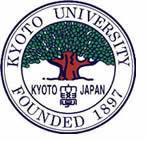 Kyoto University
Kyoto University
? Development of the unique laser spectroscopy and apply to several optical materials
Many kinds of photonics materials have been developed and used for wider industrial and medical fields. Even more highly efficient and functional photonics devices are expected for future technology and society. In order to develop the photonics devices, detail elucidation and understanding of the optical properties and dynamics are necessary, but it is very difficult by using only traditional spectroscopic techniques. Therefore, we developed the unique and novel laser spectroscopic techniques, for example, Time resolved micro photoluminescence spectroscopy (TR-m-PL), scanning near-field optical microscopy (NSOM)) with illumination-collection mode, third order nonlinear optical spectroscopy, photo-thermal microscopic spectroscopy, Raman spectroscopy with scanning confocal laser microscopy, etc. We apply these technique for several photonics materials, for example, semiconductors (GaN, ZnSe, ZnO-based quantum well, quantum dot, etc.), organic thin films (polysilane films, Alq3-based EL , etc.), nano-metal-particles (Pt, Au, etc.), molecular systems (solution, micelle, LB-layer, liquid crystal, etc.), and biological living cells (plant cell, nerve or liver cell of mouse, dopamine), etc.
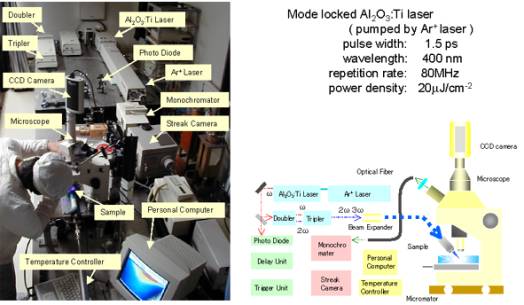
Time-resolved micro-photoluminescence Spectroscopy
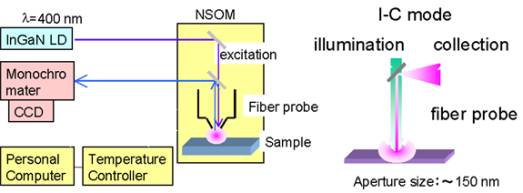
Scanning Near-field Optical Microscopy
? Temporal and Spatial-resolved Nonlinear Spectroscopy of InGaN/GaN
Currently, InGaN/GaN based quantum well (QW) optical devices (light emitting diodes; LED and laser diode; LD) have been studied and developed for a wide range of applications. Recently, we have reported on the temporal and spatial resolved observation of the radiative processes in InGaN/GaN-based QW probed by time-resolved micro-photoluminescence (TRMPL) and scanning near-field optical microscopy (NSOM). The device performances and optical emission properties of InGaN/GaN LEDs are determined by both radiative and nonradiative processes of carriers in InGaN active layers. However, only few investigations have so far been conducted to experimentally elucidate the nonradiative processes (thermalization, heat conduction and carrier diffusion), primarily due to the difficult nature of such measurements. We investigated the temporal and spatial-resolved nonlinear spectroscopy for the direct observation of the nonradiative processes of InGaN/GaN. We developed transient grating (TG) and transient lens (TL) spectroscopy which are one of the third order nonlinear spectroscopy. For TG, bright-dark stripe patterned modulations of the optical properties were created by the crossing of two pump beams and detected by the diffraction of the probe beam. On the other hand, for TL, Gaussian shaped spatial distribution of optical properties was created and detected by focus/defocus of the probe beam. Such modulations of optical properties are attributed to some nonradiative processes in materials (carrier dynamics, thermal dynamics, etc.). We obtained the time profiles of the TG and TL signals with picosecond and nanosecond time-scales. The signals have two components; a spike-like positive component of the refractive index change (Δn>0) and a slowly-decaying negative component (Δn<0). From the relationship of (∂n/∂N)>0 and (∂n/∂T)<0 in GaN, the fast and slow components were assigned to the carrier density change (ΔN) and the temperature change (ΔT), respectively. By fitting of the TG and TL time profiles, the carrier density and recombination rate and diffusivity were obtained by the signal intensity and decay of the fast component. On the other hand, the thermal energy released by the nonradiative recombination and the heat conductivity were obtained by the slow signal component. In order to know the special-resolved properties, for example the correlation between the optical property and threading dislocation density, time-resolved micro photoluminescence (TRMPL) spectroscopy was also developed and used. We found that both the intensities and the time profiles of the signal were different at high TD (109 cm-2) seed region and the low TD (106 cm-2) wing region of the air-bridged lateral epitaxial growth GaN and InGaN/GaN.

Optical configuration of the third order nonliner spectroscopy (Transient Grating Method)
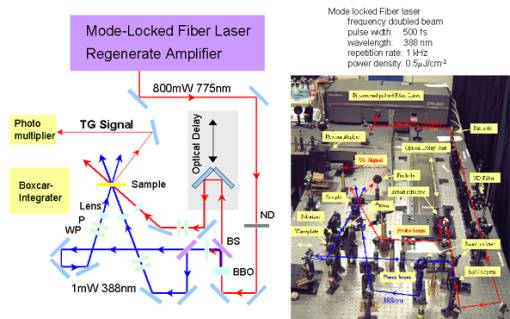
Transient Grating Method with femtosecond pulse laser syatem
? Spectroscopy of Biological Cell
The native fluorescence properties of dopamine were examined aiming the direct visualization of dopamine dynamics in the living cell. Dopamine hydrochloric acid salt in aqueous solution was excited at 266 nm femtosecond laser and the sufficient fluorescence emission peaking at 330 nm was detected with a streak camera. The fluorescence decay curve was fitted by single-exponential functions, with the lifetime of approximately 0.80 ns. The influence of deep-UV laser excitation on cells is also discussed for the direct observation of dopamine in the living cells. In addition, it is needed to detect the dopamine fluorescence in the living cell sensitively and separately from emission of other fluorescent species. When instrumental arrangement and time-resolved spectral analysis can make it possible to solve such problems, direct visualization of the secretion process of individual cells will be achieved by the laser-induced native fluorescence imaging microscopy, without using any additional fluorescent probes. This quantitative imaging technique will provide a useful noninvasive approach for the study of dynamic cellular changes and the understanding of the molecular mechanisms of information transporting. This direct imaging technique can be developed to apply a quantitative analysis, and can provide a useful noninvasive approach for the study of dynamic cellular changes and the understanding of the molecular mechanisms of secretory or information transportation processes. At the same time we are investigation the diffusion process of dopamine in solution by using Taylor dispersion technique and transient grating technique The diffusion properties in solution from these measurements will also serves as a basic data to understanding the dopamine behavior in the living cell”.
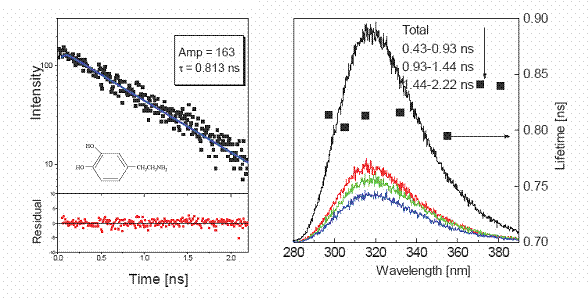
Time-resolved fluorescent measurement of dopamine chloride acid salt in water.
(Return to Top)
Graduate Research in Kyoto University (1992-1998)
? Molecular dynamics of chemical reaction intermediate spaces probed by the nonlinear spectroscopy
Molecular dynamics (translation, rotation, and vibration) in solution is fundamental and important factor in chemistry and physics and attracted many investigations for a long time. Especially, molecular translation diffusion processes is very important processes because chemical reactions in solutions are usually limited by the mutual molecular diffusion. Therefore, the diffusion coefficients (Ds) have been measured by many methods. However, only few attempts had so far been made to elucidate the Ds of chemical reaction intermediate radicals mainly because of the experimental difficulties although it is very important to understand the mechanism and dynamics of chemical reactions in a fluid.
In my doctoral thesis, we succeeded in the first ever to measure Ds values of the short-lived radicals accurately by using the laser induced transient grating (TG) method which is one of the third order nonlinear spectroscopy. We found that Ds of the radicals created by photoinduced hydrogen abstracted reactions of ketons, quinines, and azoaromatic compounds from organic solvent are 2-3 times smaller than those of the parent molecules, even though the radicals and parent molecules possess nearly the same sizes and the same shapes. This surprising discovery of the anomalously slow diffusion of the radicals had a great impact on physics, chemistry, and other related research fields. By the extended investigation, such as the solvent dependence, the solute size dependence, the temperature dependence, it was found that the activation energies for diffusion of the radicals are larger than those of the parent molecules. This fact suggests the existence of an unknown strong intermolecular interaction between the radicals and the surrounding molecules. According to this fact, theory and analysis of the chemical reactions in solutions based on the simple hydrodynamic theory should be modified. We proposed that Ds of radicals could not be estimated by Ds of the stable molecules of similar size and shape.
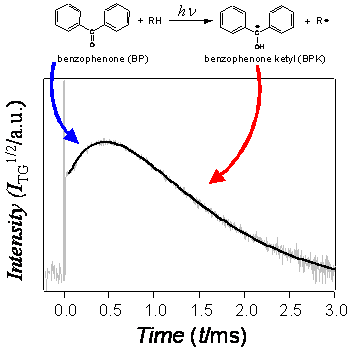
Time profile of the TG signal taken for benzophenone in tetradecane solution.
On the other hand, Ds of the benzyl radical created by the photo-dissociation from dibenzyl ketone do not diffuse anomalously slowly but similar to the stable molecules. We compared the properties of benzyl radical with those of the other radicals produced by hydrogen abstraction in order to find a possible origin of the anomalous diffusion. The reasonable origin of the anomalous diffusion of the radicals were proposed by the theoretical chemistry group in Kyoto University by using the ab initio molecular orbital (MO) calculation of the intramolecular charge polarization indused by the external electrostatic field on each atoms in molecule. They found that the partial charge polarization of pyrazinyl radical and benzophenon ketyl radial were remarkably enhanced compare to the parent molecules pyrazine and benzophenon. They proposed that this remarkably enhancement of the partial charge polarization bring the strong radival-solvent interaction, which is the origin of the anomalous slow diffusion phenomenon. They also showed that the D of pyrazinyl radical was slower than that of pyrazine by using the molecular dynamics (MD) simulation with the partial change polarization effect. They described that the mechanism of the enhancement of partial charge polarization of radicals is due to the σ-π mixture orbital reformed from the π-conjugated orbital in solute molecules. Thus, our results were supported by theoretically and, at the same time, contributed to the development of the field of the theoretical chemistry.
Other kinds of interesting molecular dynamics of radicals, ions, and radical ions were also founded in the aqueous, mixed, and micellar solutions. Accordingly, our results brought the foundation of the new research field of “Radical Chemistry”.
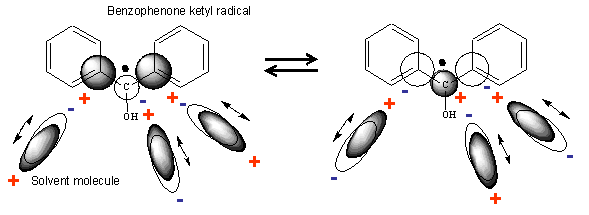
Special solute-solvent intermolecular interaction based on the intra-molecular partial charge polarization
(Return to Top)